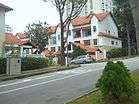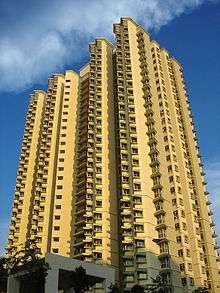Jurong West
| Jurong West | |||||||
|---|---|---|---|---|---|---|---|
| Planning Area and HDB Town | |||||||
| Other transcription(s) | |||||||
| • Chinese | 裕廊西 | ||||||
| • Pinyin | Yù Láng Xī | ||||||
| • Hokkien | Jū-lông-sai | ||||||
| • Malay | Jurong West | ||||||
| • Tamil | ஜூரோங் மேற்கு | ||||||
From top left to right: Jurong Point with Boon Lay MRT Station in the foreground, Flats along Jurong West Street 81, Jurong West Sports and Recreation Centre, Terraced housing along Westwood Avenue, Flats along Jurong West Street 91 | |||||||
 Jurong West Location of Jurong West within Singapore | |||||||
| Coordinates: SG 1°20′40.20″N 103°42′24.54″E / 1.3445000°N 103.7068167°E | |||||||
| Country |
| ||||||
| Region |
| ||||||
| CDC | |||||||
| Town councils |
| ||||||
| Constituencies | |||||||
| Government | |||||||
| • Mayor |
South West CDC | ||||||
| • Members of Parliament |
Chua Chu Kang GRC
Jurong GRC West Coast GRC Hong Kah North SMC Pioneer SMC | ||||||
| Area[1][2] | |||||||
| • Total | 14.69 km2 (5.67 sq mi) | ||||||
| • Residential | 4.8 km2 (1.9 sq mi) | ||||||
| Population (2015)[1][2] | |||||||
| • Total | 272,660 | ||||||
| • Density | 19,000/km2 (48,000/sq mi) | ||||||
| Demonym(s) |
Official
Colloquial
| ||||||
| Postal district | 22 | ||||||
| Dwelling units | 70,323 | ||||||
| Projected ultimate | 94,000 | ||||||
Jurong West /dʒuːrɒŋ wɛst/ (Chinese: 裕廊西, Tamil: ஜூரோங் மேற்கு) is a planning area and residential town located in the West Region of Singapore. It is bounded by the planning areas of Tengah and the Western Water Catchment to the north, Boon Lay and Pioneer to the south and Jurong East to the east.
Created by the Housing and Development Board after the dissolution of Jurong Town in 1979,[3] Jurong West New Town has been the center of public housing development in the Jurong region since the 1980s. Today, Jurong West is home to a large demographic of residents, making it the second most populated new town in Singapore.
Subzones

There are 9 subzones in Jurong West,[4] namely:
History
The development of Jurong started in the 1970s when estates such as Boon Lay Place, Taman Jurong, Bukit Batok, Bukit Gombak, Hong Kah, Teban Gardens and Yuhua were built, mostly due to the resettlement of Hong Kah and surrounding villages. Boon Lay Place, Taman Jurong and Hong Kah formed Jurong West.
In the 1950s, Jurong West was mainly dominated by swamps with low hills covered by shrubs and a thick jungle. It was developed into an industrial estate in the 1960s, supported by low-cost housing. Amenities such as government dispensaries, a private hospital, creches, hawker centres and banks were built in the 1970s during efforts to develop Singapore economically.
Up to the late 1980s, only part of the Jurong West housing estate had been developed, specifically the area between Boon Lay Place estate and Jurong East. In the early 1990s, a new section of Pioneer Road North was built to connect the present Jurong West Extension to Upper Jurong Road. This signalled the start of the development of Jurong West Extension. Today, the area is also served by the PIE which was extended to Tuas from Corporation Road, also in the early 1990s.
In 1982, Jurong West New Town started expanding as Jurong West Extension, which saw the realignment of the PIE to make it go through the southern boundary of present-day NTU, while converting the former section into Jurong West Avenue 2 and renaming the original Upper Jurong Road into Jurong West Avenue 4. Pioneer Road was extended North wards from present-day Upper Jurong Road as Pioneer Road North to the new PIE exit, which signalled the start of the development of Jurong West Extension (Nanyang, Jurong West Central and Gek Poh).[5] The N9 estate was the first to be built and the N6 estate was the last, in the early 2000s. The MRT Line was extended from Lakeside to Boon Lay in 1990 and again to Pioneer in 2009.
Located next to the Jurong Industrial Estate, managed by JTC, it is common to find foreign workers hanging out in the neighborhood and influx of foreign workers and foreign expatriates in the region has been a concern among the residents in the area.
Politics
Though a single neighborhood, Jurong West is divided into three GRCs (Chua Chu Kang, Jurong and West Coast) and two SMCs (Hong Kah North and Pioneer) and with 3 Town Councils managing different parts of the neighborhood, namely the Jurong-Clementi Town Council, West Coast Town Council and Chua Chu Kang Town Council.
Nonetheless, though divided into smaller constituencies, the neighborhood is collectively managed by the PAP.
Transport
Jurong West is connected through the two MRT stations Boon Lay and Pioneer respectively, with one bus interchange integrated into Boon Lay MRT Station.
Tourism
- Singapore Discovery Centre
- Singapore Army Museum
Retail
The largest suburban mall in Singapore, Jurong Point Shopping Mall is well-accessible by bus services from all the residential precincts of Jurong except Yuhua and Teban Gardens. This mall targets the young adults and family populations with stalls selling fashion, food and beverage, sports, entertainment and lifestyle products, and the elderly population with body-wellness stores and healthcare centres. It is well linked to the Boon Lay MRT Station and Boon Lay Bus Interchange.
There are other shopping malls in Jurong but are well-known only within the precinct they are in, such as 'Hong Kah Point' in Hong Kah and 'Taman Jurong Shopping Centre' in Taman Jurong. Therefore, it is recommended that one should read the pages of the various precincts to understand more about the shopping centres in Jurong.
Education
There are 24 primary and secondary schools in Jurong West and 1 JC, The Nanyang Technological University, a major university in Singapore is located at Yunnan
Primary Schools
- Boon Lay Garden Primary School
- Corporation Primary School
- Frontier Primary School
- Jurong West Primary School
- Juying Primary School
- Lakeside Primary School
- Pioneer Primary School
- Rulang Primary School
- Shuqun Primary School
- West Grove Primary School
- Westwood Primary School
- Xingnan Primary School
Secondary Schools
- Boon Lay Secondary School
- Fuhua Secondary School
- Hong Kah Secondary School
- Hua Yi Secondary School
- Jurong Secondary School
- Jurong West Secondary School
- Juying Secondary School
- Pioneer Secondary School
- River Valley High School
- Westwood Secondary School
- Yuan Ching Secondary School
- Yuhua Secondary School
Junior Colleges
Universities
Other Schools
- Canadian International School (Lakeside Campus)
- Grace Orchard School
External links
- Jurong Point shopping centre
- Singapore Discovery Centre
- Southwest CDC Website
- Jurong West EC Website
References
- 1 2 City Population - statistics, maps and charts | Jurong west
- 1 2 HDB Key Statistics FY 2014/2015
- ↑ "Jurong flats: HDB takes over from JTC". The Straits Times. 2 June 1979.
- ↑ Singapore Department of Statistics - Planning Areas/Subzones in Singapore (Year 2015)
- ↑ "New Jurong West to be twice as big". The Straits Times. 2 April 1986. p. 9.
| Wikimedia Commons has media related to Jurong West. |






